Newton's Laws of Motion
Limits of Classical Mechanic
Classical Mechanics is the formulations of physics developed by Newton (1642-1727), Lagrange(1736-1813), and Hamilton(1805-1865).
It may be used to describe the motion of objects which are not moving at high speeds (0.1[math] c[/math]) nor are microscopically small ( [math]10^{-9} m[/math]).
The laws are formulated in terms of space, time, mass, and force:
Space and Time
Space
Cartesian, Spherical, and Cylindrical coordinate systems are commonly used to describe three-dimensional space.
Cartesian
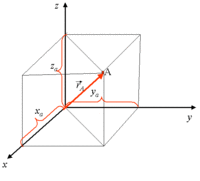
Vector Notation convention:
Position:
- [math]\vec{r} = x \hat{i} + y \hat{j} + z \hat{k} = (x,y,z) = \sum_1^3 r_i \hat{e}_i[/math]
Velocity:
- [math]\vec{v}[/math] = [math]\frac{d \vec{r}}{dt}[/math] = [math]\frac{d x}{dt}\hat{i} + x\frac{d \hat{i}}{dt} + \cdots[/math]
cartesian unit vectors do not change with time (unit vectors for other coordinate system types do)
- [math]\frac{d \hat{i}}{dt} =0 =\frac{d \hat{j}}{dt} =\frac{d \hat{k}}{dt}[/math]
- [math]\vec{v}[/math] = [math]\frac{d \vec{r}}{dt}[/math] = [math]\frac{d x}{dt}\hat{i} + \frac{d y}{dt}\hat{j} + \frac{d z}{dt}\hat{k} [/math]
Similarly Acceleration is given by
- [math]\vec{a}[/math] = [math]\frac{d \vec{v}}{dt}[/math] = [math]\frac{d^2 x}{dt^2}\hat{i} + \frac{d^2 y}{dt^2}\hat{j} + \frac{d^2 z}{dt^2}\hat{k} [/math]
Polar
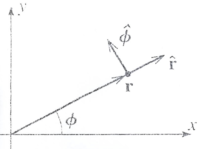 Vector Notation convention:
Vector Notation convention:
Position:
Because [math]\hat{r}[/math] points in a unique direction given by [math]\hat{r} = \frac{\vec{r}}{|r|}[/math] we can write the position vector as
- [math]\vec{r} = r \hat{r}[/math]
- [math]\vec{r} \ne r \hat{r} +\phi \hat{\phi} [/math]: [math]\phi[/math] does not have the units of length
The unit vectors ([math]\hat{r}[/math] and [math]\hat{\phi}[/math] ) are changing in time. You could express the position vector in terms of the cartesian unit vectors in order to avoid this
- [math]\vec{r} = r \cos(\phi) \hat{i} + r \sin(\phi)\hat{j}[/math]
The dependence of position with [math]\phi[/math] can be seen if you look at how the position changes with time.
Velocity in Polar Coordinates
Consider the motion of a particle in a circle. At time [math]t_1[/math] the particle is at [math]\vec{r}(t_1)[/math] and at time [math]t_2[/math] the particle is at [math]\vec{r}(t_2)[/math]
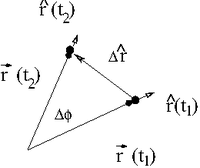
If we take the limit [math]t_2 \rightarrow t_1[/math] ( or [math]\Delta t \rightarrow 0[/math]) then we can write the velocity of this particle traveling in a circle as
- [math]\hat{r} (t_2)-\hat{r}(t_1) \equiv \Delta \hat{r} = \Delta \phi \hat{\phi}[/math]
- or
- [math]\frac{ d \hat{r}}{dt} = \frac{d \phi}{dt} \hat{\phi}[/math]
Thus for circular motion at a constraint radius we get the familiar expression
- [math]\vec{v} = \lim_{\Delta t \rightarrow 0} \frac{\vec{r}(t_2)-\vec{r}(t_1)}{\Delta t}= \lim_{\Delta t \rightarrow 0} \frac{r\left( \hat{r}(t_2) - \hat{r}(t_1)\right)}{\Delta t} = r \frac{\Delta \phi}{\Delta t} \hat{\phi} = r \omega \hat{\phi}[/math]
- [math]\vec{v} = r \frac{d \phi}{dt} \hat{\phi}[/math]
If the particle is not constrained to circular motion ( i.e.: [math]r[/math] can change with time) then the velocity vector in polar coordinates is
- [math]\vec{v}[/math] = [math]\frac{d r}{dt}\hat{r} + r\frac{d \phi}{dt} \hat{\phi}[/math]
- or in more compact form
- [math]\vec{v}=\vec{\dot{r}} = \dot{r} \hat{r} + r \dot{\phi} \hat{\phi}= v_r \hat{r} + v_{\phi} \hat{\phi}[/math]
- linear velocity [math]\equiv v_r [/math] Angular velocity [math]\equiv v_{\phi} [/math]
Acceleration in Polar Coordinates
Taking the derivative of velocity with time gives the acceleration
- [math]\vec{a} = \frac{d \vec{v}}{dt} =\vec{\ddot{r}} [/math]
- [math]= \frac{ d \left (\dot{r} \hat{r} + r \dot{\phi} \hat{\phi}= v_r \hat{r} + v_{\phi} \hat{\phi}\right)}{dt}[/math]
- [math]= \left ( \frac{ d \dot{r}}{dt} \hat{r} + \dot{r} \frac{ d\hat{r}}{dt} \right) + \left ( \frac{d r}{dt} \dot{\phi} \hat{\phi} +r \frac{d \dot{\phi}}{dt} \hat{\phi} +r \dot{\phi} \frac{d \hat{\phi}}{dt} \right )[/math]
- [math]= \left ( \ddot{r} \hat{r} + \dot{r} \dot{\phi}\hat{\phi} \right) + \left ( \dot{r} \dot{\phi} \hat{\phi} +r \ddot{\phi} \hat{\phi} +r \dot{\phi} \frac{d \hat{\phi}}{dt} \right )[/math]
We need to find the derivative of the unit vector [math]\hat{\phi}[/math] with time.
Consider the position change below in terms of only the unit vector [math]\hat{\phi}[/math]
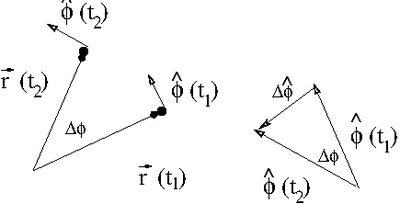
Using the same arguments used to calculate the rate of change in [math]\hat{r}[/math]:
If we take the limit [math]t_2 \rightarrow t_1[/math] ( or [math]\Delta t \rightarrow 0[/math]) then we can write the velocity of this particle traveling in a circle as
- [math]\hat{\phi} (t_2)-\hat{\phi}(t_1) \equiv \Delta \hat{\phi} = \Delta \phi (- \hat{r})[/math]
- or
- [math]\frac{ d \hat{\phi}}{dt} = -\frac{d \phi}{dt} \hat{r}[/math]
- [math]\frac{d \hat{\phi}}{dt}= -\dot{\phi} \hat{r}[/math]
Substuting the above into our calculation for acceleration:
- [math]\vec{a} = \left ( \ddot{r} \hat{r} + \dot{r} \dot{\phi}\hat{\phi} \right) + \left ( \dot{r} \dot{\phi} \hat{\phi} +r \ddot{\phi} \hat{\phi} +r \dot{\phi} \frac{d \hat{\phi}}{dt} \right )[/math]
- [math]= \left ( \ddot{r} \hat{r} + \dot{r} \dot{\phi}\hat{\phi} \right) + \left ( \dot{r} \dot{\phi} \hat{\phi} +r \ddot{\phi} \hat{\phi} +r \dot{\phi} \left( -\dot{\phi} \hat{r}\right) \right )[/math]
- [math]= \left ( \ddot{r} r \dot{\phi} -\dot{\phi}^2 \right) \hat{r} + \left ( 2\dot{r} \dot{\phi} +r \ddot{\phi} \right ) \hat{\phi} [/math]
Cylindrical
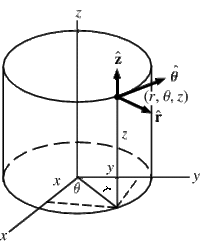
Spherical
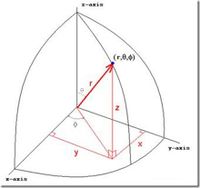
Vectors
Scaler ( Dot ) product
Vector ( Cross ) product
Forest_Ugrad_ClassicalMechanics





